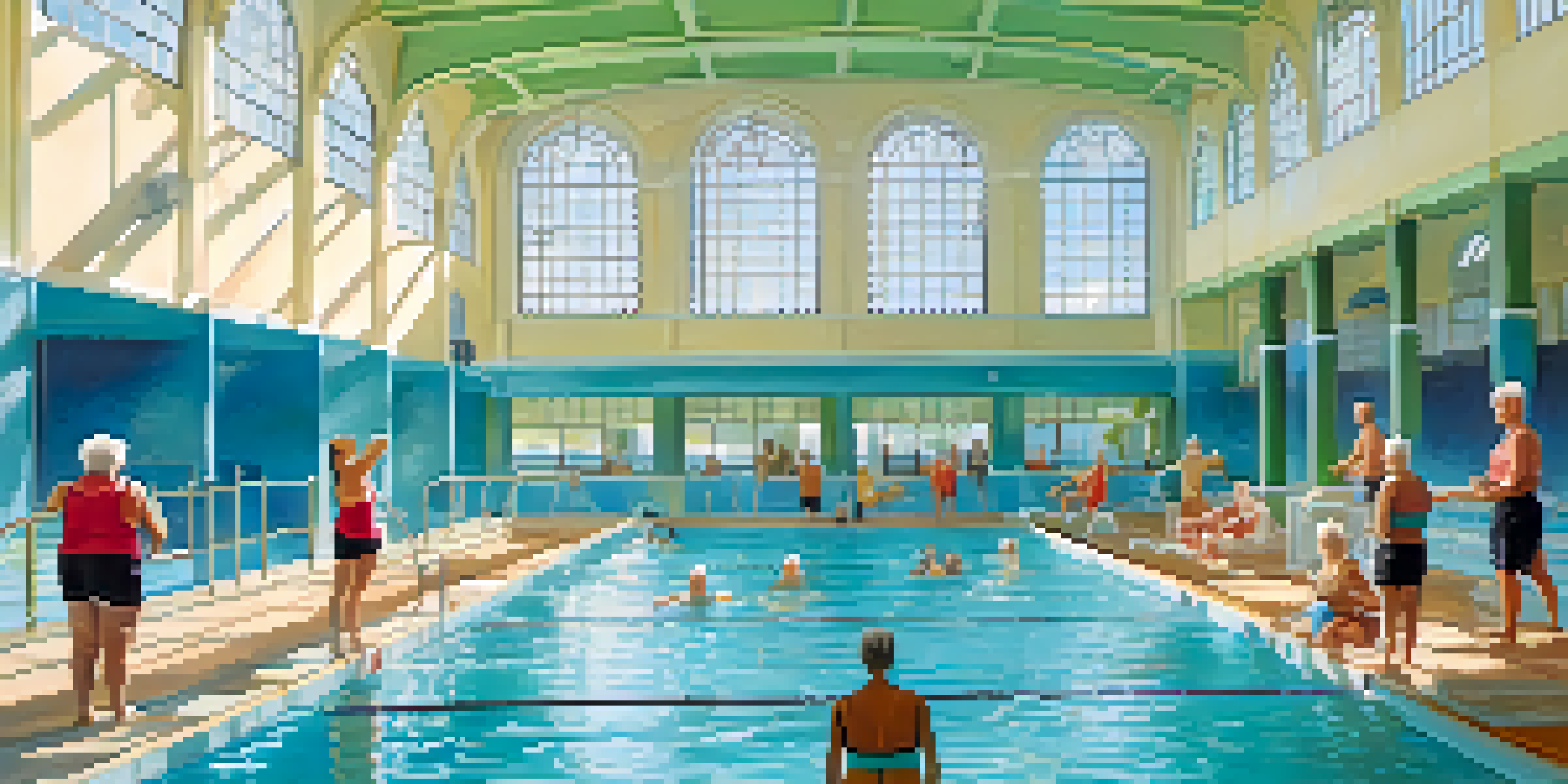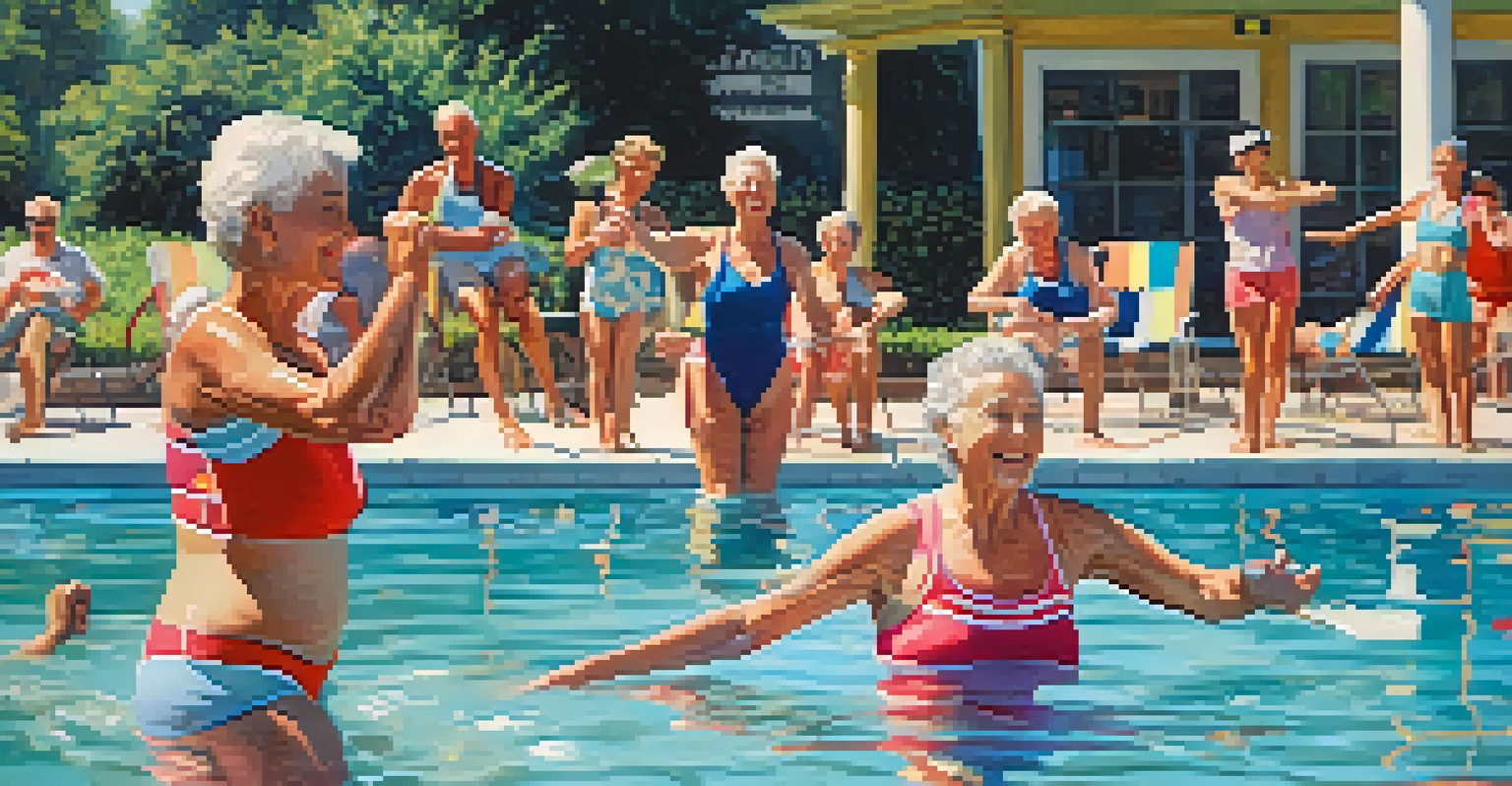Adapting Aquatic Exercises for Seniors and Special Populations

Understanding the Benefits of Aquatic Exercises
Aquatic exercises provide a low-impact workout that is gentle on the joints, making them an excellent option for seniors and special populations. The buoyancy of water supports the body, reducing the stress on bones and muscles while allowing for greater mobility. This makes water-based activities ideal for those recovering from injuries or managing chronic conditions.
Exercise is like telling your body 'you're gonna hate me for this, but you’ll thank me later.'
Moreover, exercising in water can enhance cardiovascular health, improve balance, and increase flexibility. The natural resistance of water also helps build strength without the need for heavy weights. For seniors, these benefits can translate into improved daily function and a greater sense of independence.
Finally, aquatic exercises can foster social interaction, as many classes are conducted in groups. This not only makes workouts more enjoyable but also combats feelings of isolation that some seniors may experience. The combination of physical and emotional benefits truly makes aquatic exercise a holistic approach to fitness.
Assessing Individual Needs and Limitations
Before beginning any aquatic exercise program, it's essential to assess the individual needs and limitations of seniors and special populations. This involves understanding their medical history, any physical limitations, and personal fitness goals. A consultation with a healthcare provider can help identify specific considerations that may affect participation in water exercises.

For instance, someone with arthritis may require gentler movements and more focus on flexibility, while another individual may be seeking ways to build strength. By tailoring the exercises to the person's needs, we can ensure a safe and effective workout. This personalized approach encourages participants to feel more confident and engaged in their fitness journey.
Aquatic Exercises for Joint Health
Aquatic exercises are low-impact and gentle on the joints, making them ideal for seniors and those with chronic conditions.
Additionally, it's important to consider the environment in which the exercises will take place. Features such as water depth, temperature, and accessibility can all impact a person's ability to participate comfortably. A thoughtful assessment can lead to a more enjoyable and beneficial exercise experience.
Choosing the Right Aquatic Environment
The environment where aquatic exercises take place plays a crucial role in ensuring safety and effectiveness. Indoor pools are often preferred for seniors and special populations due to controlled temperatures and accessibility features, such as ramps and handrails. Outdoor pools can be enjoyable, but weather conditions may pose challenges.
The greatest wealth is health.
It's also important to consider the depth of the water. Shallow water is ideal for beginners or those with limited mobility, as it allows for easier access and greater confidence. Gradually increasing water depth can provide additional challenges as participants improve their skills and comfort levels.
Lastly, the social atmosphere of the aquatic environment can greatly influence motivation and enjoyment. Group classes can foster a sense of community, encouraging participants to engage with one another and share their experiences. This not only enhances the workout but can also lead to lasting friendships.
Incorporating Warm-Up and Cool-Down Routines
Just like any workout, incorporating warm-up and cool-down routines is essential for aquatic exercises, especially for seniors and individuals with special needs. A proper warm-up prepares the muscles for activity, reducing the risk of injury and improving overall performance. Simple movements such as gentle arm circles and leg swings can effectively increase circulation and flexibility.
Cooling down is equally important, as it helps the body transition back to a resting state. Gradually decreasing the intensity of movements allows the heart rate to lower safely, while stretching exercises in the water can promote muscle relaxation. This practice can also help alleviate soreness and stiffness after a workout.
Personalized Approach to Fitness
Assessing individual needs and tailoring aquatic exercises ensures safe and effective workouts for participants of varying abilities.
Establishing a routine that includes both warming up and cooling down sets a positive tone for the entire exercise session. It reinforces the importance of taking care of one's body and can help participants feel more connected to their fitness goals.
Adapting Exercises for Varying Abilities
One of the greatest advantages of aquatic exercises is their adaptability for individuals with varying abilities. For those who may feel insecure or lack strength, water provides a supportive medium to perform movements safely. Simple modifications, like using a pool noodle for buoyancy, can make exercises accessible for everyone.
For example, a seated leg lift can be performed while holding onto the edge of the pool for stability, allowing individuals with mobility issues to participate comfortably. Additionally, exercises like water walking or gentle arm movements can be tailored to accommodate different fitness levels. The versatility of aquatic exercises means that everyone can find a suitable option to enhance their physical health.
It's also beneficial to encourage participants to listen to their bodies and adjust the intensity as needed. Empowering individuals to make these choices fosters independence and helps them develop a positive relationship with exercise. By focusing on ability rather than limitation, we create an inclusive environment for all.
Utilizing Equipment for Enhanced Workouts
Incorporating various pieces of equipment can enhance aquatic exercises and provide added motivation for seniors and special populations. Tools like water dumbbells, resistance bands, and kickboards can introduce new challenges and keep workouts fresh and engaging. These items are designed to be safe and easy to use in the water, allowing participants to focus on their movements.
For example, water dumbbells offer resistance that can help build strength in a low-impact way. Using them during arm exercises can target specific muscles while minimizing strain on the joints. Similarly, resistance bands can be utilized to perform a range of movements that promote flexibility and strength.
Building Community and Support
Creating a supportive environment fosters motivation and connection among participants, enhancing their overall experience in aquatic exercise programs.
While equipment can enhance workouts, it’s essential to ensure that participants are comfortable using them. Offering guidance and demonstrations can help build confidence and ensure everyone knows how to use the equipment safely. This approach not only improves physical fitness but also promotes a sense of accomplishment.
Creating a Supportive Community for Participants
Building a supportive community is vital for encouraging participation in aquatic exercises among seniors and special populations. Creating an inviting atmosphere fosters camaraderie and motivation, making the experience more enjoyable for everyone involved. Whether it’s through group classes or social events, connection is key.
Encouraging participants to share their stories and experiences can foster a sense of belonging. This not only helps individuals feel more engaged but can also create a support network that motivates them to continue their fitness journey. Celebrating small victories together can further enhance this sense of community.

Additionally, regular communication and feedback can help ensure that everyone feels valued and heard. Listening to participants' concerns and suggestions allows for continued improvement of the program, ultimately leading to a more fulfilling experience. When individuals feel supported, they are more likely to embrace the benefits of aquatic exercise.